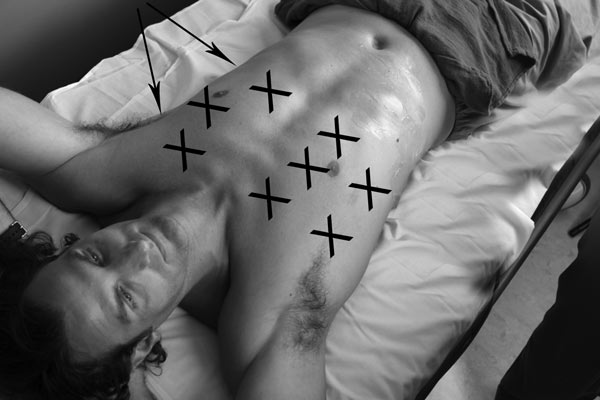This is an 34 y/o male smoker who presents with 4 hours of sharp right sided chest pain, worse with deep inspiration. Vitals normal.
Diagnosis: pneumothorax
This smoker presented with pleuritic chest pain, and during the initial evaluation, a right thoracic ultrasound was performed to evaluate for pneumothorax (PTX). The ultrasound finding here is called a “lung point sign,” and is highly specific for PTX.1,2 This sign can be identified at border of the PTX: as the pt breathes the lung comes in and out of view.
Take home points:
- To perform this scan, the patient should lie supine, and multiple anterior scanning locations should be identified on the suspect side, starting at the level of the nipple.
- While most lung pathology can be identified using a lower frequency probe, lung sliding is best seen using a linear transducer.
- Presence of lung sliding (commonly described as ants marching) nearly rules out PTX at that rib space.3,4
- Absence of lung sliding can be due to PTX, but also can be due to surgical scarring, previous pleurodesis, pneumonia, and pulmonary contusions.5
- When you have identified a lung point, ensure that you are not near the diaphragm or heart, as the scan can have a similar appearance.
- M-mode may be used to document the lack or presence of lung sliding, but does not provide any additional information that cannot be obtained viewing the live scan (or saved clip).
- Subcutaenous air, commonly seen in traumatic PTX, blocks ultrasound waves preventing this scan from being diagnostic. Other testing modalities should be pursued.
- B-Lines rule out PTX at that rib space as well.

- Lichtenstein D, Mezière G, Biderman P, Gepner A. The “lung point”: an ultrasound sign specific to pneumothorax. Intensive Care Med. 2000;26(10):1434-40. [pubmed]
- Lichtenstein DA, Mezière G, Lascols N, et al. Ultrasound diagnosis of occult pneumothorax. Crit Care Med. 2005;33(6):1231-8. [pubmed]
- Blaivas M, Lyon M, Duggal S. A prospective comparison of supine chest radiography and bedside ultrasound for the diagnosis of traumatic pneumothorax. Acad Emerg Med. 2005;12(9):844-9. [PDF]
- Rowan KR, Kirkpatrick AW, Liu D, Forkheim KE, Mayo JR, Nicolaou S. Traumatic pneumothorax detection with thoracic US: correlation with chest radiography and CT–initial experience. Radiology. 2002;225(1):210-4. [PDF]
- Dawson, Mallin. Introduction to Bedside Ultrasound, Volume 1. 2013. Apple iBook. [iBook]



